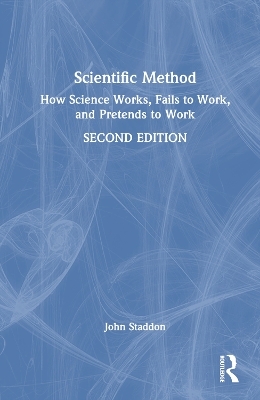
Scientific Method
How Science Works, Fails to Work, and Pretends to Work
Seiten
2024
|
2nd edition
Routledge (Verlag)
978-1-032-68389-8 (ISBN)
Routledge (Verlag)
978-1-032-68389-8 (ISBN)
This expanded second edition of Scientific Method shows how science works, fails to work, or pretends to work, by looking at examples from physics, biomedicine, psychology, sociology, and economics.
This expanded second edition of Scientific Method shows how science works, fails to work or pretends to work by looking at examples from physics, biomedicine, psychology, sociology and economics.
Scientific Method aims to help curious readers understand the idea of science, not by learning a list of techniques but through examples both historical and contemporary. Staddon affirms that if the reader can understand successful studies as well as studies that appear to be scientific but are not, they will become a better judge of the “science” in circulation today. To this end, this new edition includes a new chapter, What is Science?, which points out that science, like any human activity, has its own set of values, with truth being the core. Other new chapters focus on the emergence of AI and machine learning, science and diversity, and behavioral economics. The book also includes textual features such as bullet-points and text boxes on topical issues.
Scientific Method is essential reading for students and professionals trying to make sense of the role of science in society, and of the meaning, value and limitations of scientific methodology.
This expanded second edition of Scientific Method shows how science works, fails to work or pretends to work by looking at examples from physics, biomedicine, psychology, sociology and economics.
Scientific Method aims to help curious readers understand the idea of science, not by learning a list of techniques but through examples both historical and contemporary. Staddon affirms that if the reader can understand successful studies as well as studies that appear to be scientific but are not, they will become a better judge of the “science” in circulation today. To this end, this new edition includes a new chapter, What is Science?, which points out that science, like any human activity, has its own set of values, with truth being the core. Other new chapters focus on the emergence of AI and machine learning, science and diversity, and behavioral economics. The book also includes textual features such as bullet-points and text boxes on topical issues.
Scientific Method is essential reading for students and professionals trying to make sense of the role of science in society, and of the meaning, value and limitations of scientific methodology.
John Staddon is James B. Duke Professor of Psychology and Professor of Biology and Neurobiology, Emeritus at Duke University. He does research on adaptive behavior, economics and the history and philosophy of science.
1. What is Science? 2. Some Science History 3. Experiment 4. Null Hypothesis Statistical Testing 5. Models and Incentives 6. Social Science 7. Science and AI 8. Science and Diversity 9. Social science: What is the problem? 10. Economics and Equilibria 11. Behavioral Economics 12. Animal Economics 13. The Object of Inquiry Problem 14. Efficient Markets, I 15. Efficient Markets, II Event Studies and the CAPM 16. Summing Up
| Erscheinungsdatum | 26.04.2024 |
|---|---|
| Zusatzinfo | 6 Tables, black and white; 27 Line drawings, black and white; 4 Halftones, black and white; 31 Illustrations, black and white |
| Verlagsort | London |
| Sprache | englisch |
| Maße | 152 x 229 mm |
| Gewicht | 453 g |
| Themenwelt | Geisteswissenschaften ► Psychologie ► Allgemeine Psychologie |
| Wirtschaft ► Volkswirtschaftslehre | |
| ISBN-10 | 1-032-68389-9 / 1032683899 |
| ISBN-13 | 978-1-032-68389-8 / 9781032683898 |
| Zustand | Neuware |
| Informationen gemäß Produktsicherheitsverordnung (GPSR) | |
| Haben Sie eine Frage zum Produkt? |
Mehr entdecken
aus dem Bereich
aus dem Bereich
Techniken der Verhaltenstherapie
Buch (2024)
Julius Beltz GmbH & Co. KG (Verlag)
CHF 48,95


